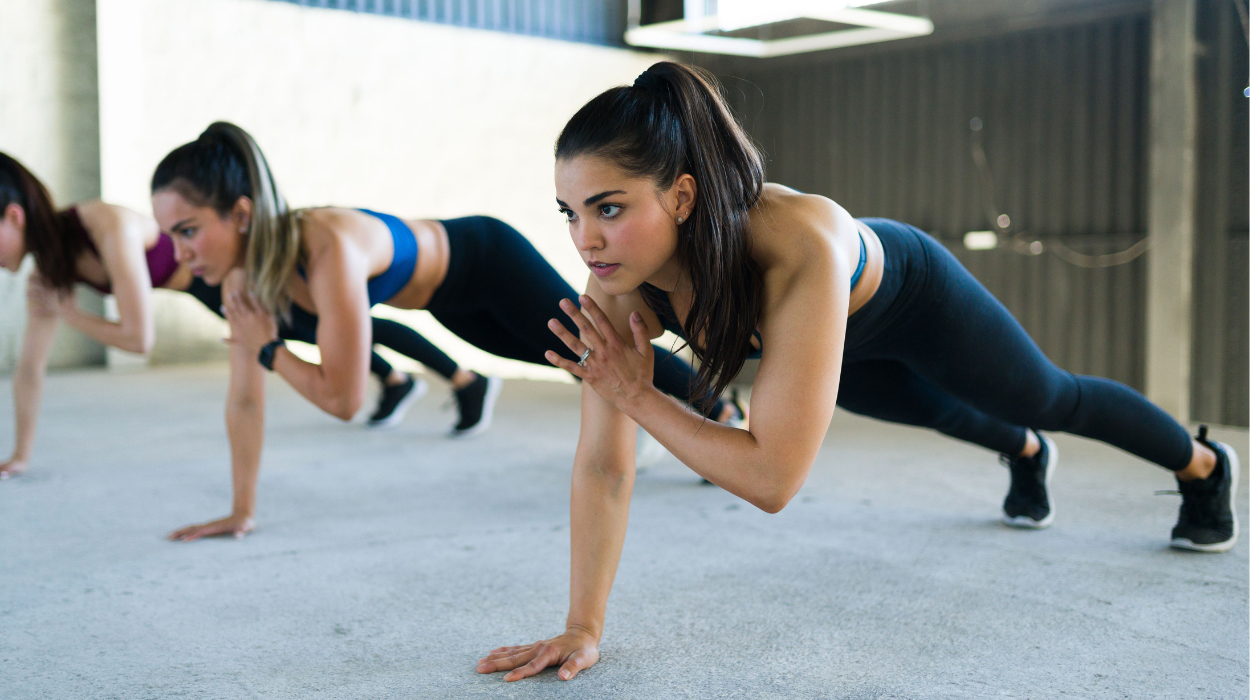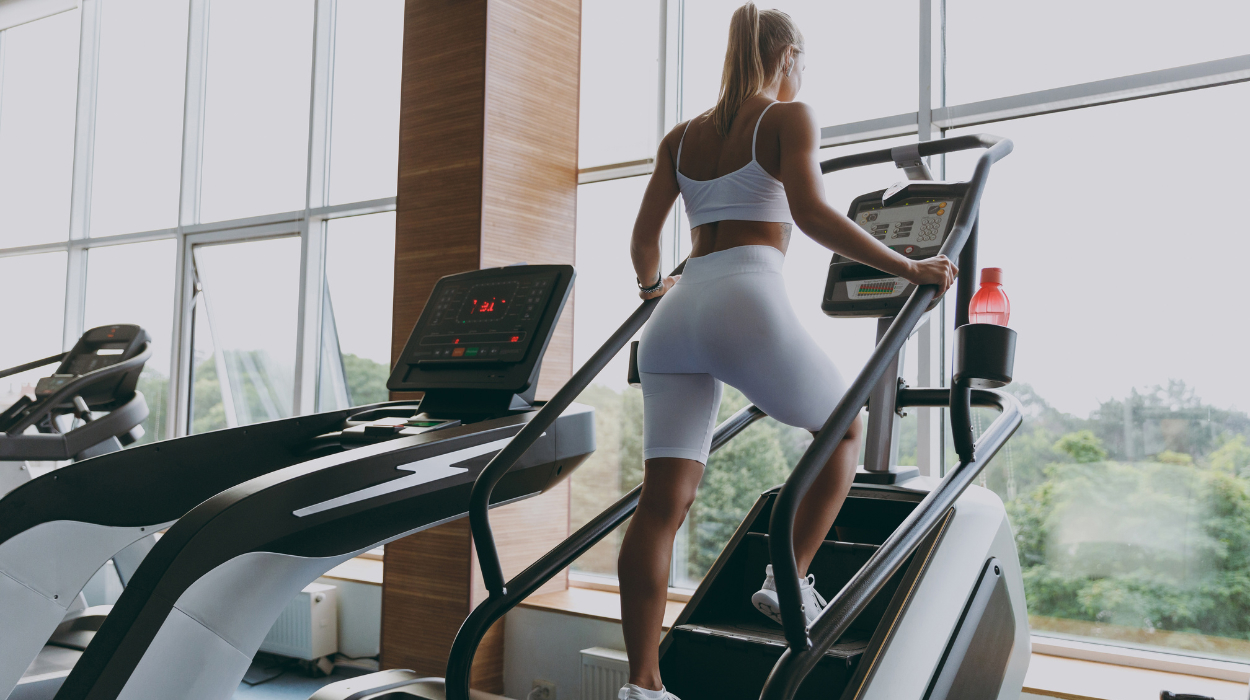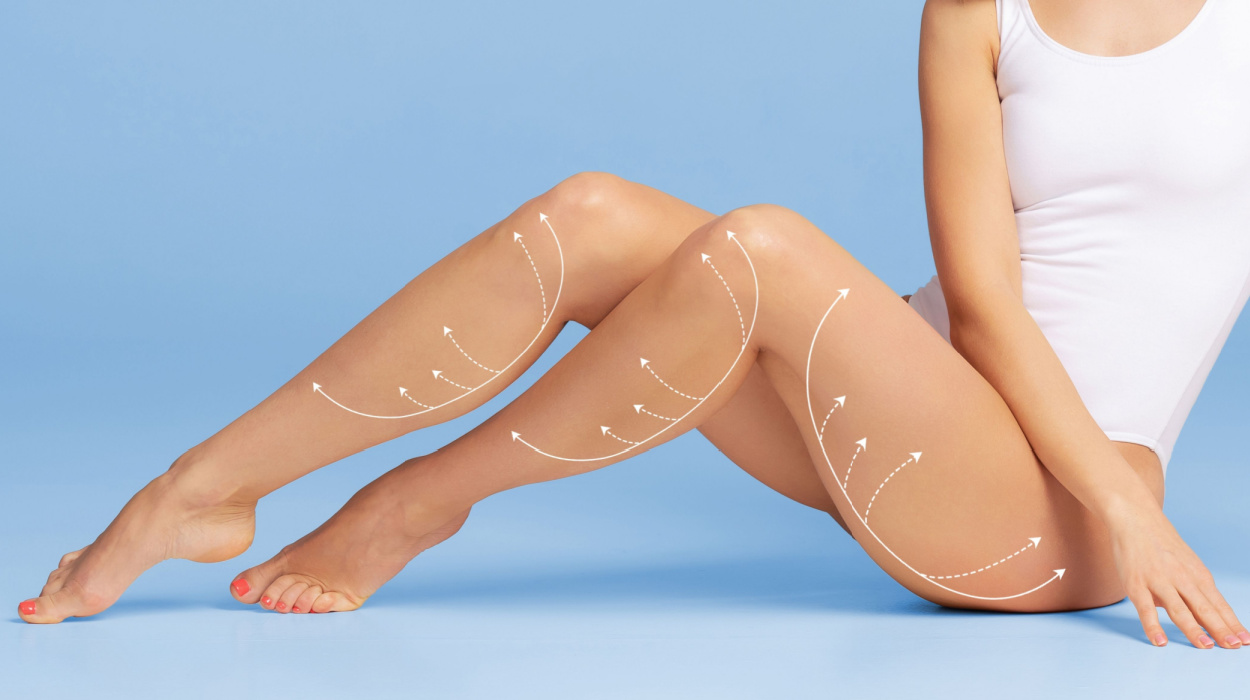Women tend to have a higher total body[1] fat than men. Women accumulate and store fat mostly in the hip and leg areas, whereas men gain in the abdominal region. These differences are due to physiology but can also be genetic.
You cannot specifically target fat loss; it occurs throughout the entire body. That being said, you may want to know how to lose leg fat in women. Are there specific dietary changes and exercises women can do to learn how to lose fat in the legs?
A healthy diet and regular exercise are essential for a healthy lifestyle and weight loss. Combining the abovementioned actions with modifying habits and implementing new methods aids in reducing body fat.
Losing weight is complex and requires a multifaceted approach. Continue reading as we dive into the details about how to get slim legs and reach your goals.
What Are The Best Exercises For Women To Lose Leg Fat?
The best leg exercises to lose leg fat are the following:
- High-intensity interval training.
- Squats and lunges.
- Inclined walking.
- Strength training.
- Pilates.
Best Exercises For Women To Get Slim Legs
Experts state that making lifestyle changes is the best approach to losing fat. Regular exercise is a significant component of a weight loss plan since it improves body composition and aids body weight reduction.[2]
The CDC recommends[3] a minimum of 150 minutes of moderate-intensity physical activity per week and 2 days of muscle-strengthening activity. Implementing this guideline will vary from person to person, depending on fitness level and age. There is a formula[4] to determine the moderate intensity for an individual.
- 220 – age = maximum age-related heart rate.
- Moderate-intensity would be 64% to 76% of maximum heart rate. For example: For a 50-year-old person, 220 – 50 = 170 beats per minute or bpm, maximum heart rate.
- 64% level: 170 x 0.64 = 109 bpm.
- 76% level: 170 x 0.76 = 129 bpm.
So, the target heart rate range for a 50-year-old individual would be 109-129 bpm.
Using a fitness device or app during exercise to monitor your heart rate will help you know if you are exercising at the intended intensity. Always begin slowly at the lower end of the target heart rate zone and work up to higher levels when you are able.
According to research, physical activity, combined with a calorie deficit, yields the best results.[5] With that in mind, some exercises are more effective than others to slim and tone legs. If you want to know how to get skinny legs, the following list advises exercises to try.
High-Intensity Interval Training

High-intensity interval training or HIIT is characterized by intermittent periods of activity and rest. HIIT can be performed in several different ways, including running, cycling, resistance, or bodyweight exercises.
A typical interval format is a 2:1 ratio of activity to rest. Therefore, a sample HIIT session might be a one-minute sprint and 30 seconds of rest. HIIT is an effective method for total body fat loss,[6] including in the hip, thighs, buttocks, and belly.
A benefit of HIIT workouts is that they are time efficient. The benefits, including fat loss, occur in half the time with HIIT compared to medium-intensity continuous training.
Squats And Lunges
Lower body exercises that incorporate multiple leg muscles are effective for toning hips, thighs, and legs. Squats and lunges are performed with body weight initially. Then, with additional resistance later, they build lean muscle mass. Improving body composition muscle-to-fat ratio increases your body’s metabolic rate, meaning you burn more fat.
Squats and lunges work the hip and thigh muscles mainly. Additionally, a 2022 study showed that lunges performed on unstable surfaces[7] increased muscle and nerve activity and were more effective in reducing body fat. Simply adding a balance disc or pad increases your calorie burn.
Many variations of squats and lunges exist. Try walking lunges, multi-directional lunges, sumo squats, and split squats to engage all the muscles in the hips and inner and outer thighs.
Inclined Walking

Walking is good exercise, but if you want to burn more calories, walk on an incline. Inclined walking kicks up the intensity of the leg muscles. Research indicates[8] that walking on a 6% grade increases calorie and fat burning compared to a flat surface.
A study compared no incline to 10% incline[9] walking, demonstrating significant muscle activity in the thigh and calf muscles. When increased to 16% incline, raised leg muscle activity and calorie burn. More muscle work means more calorie burning, which is needed to reduce body fat.
Walking uphill requires more energy from the leg muscles, resulting in increased cardiopulmonary effort. When seeking options on how to lose calf fat, females wishing for leaner calves would benefit from inclined walking. Cardio exercises burn calories, help reduce fat, and have overall health[10] benefits since they can decrease heart disease risk.
Strength Training
If you want to know how to lose thigh fat, start whole-body strength training. We know spot training the legs only for fat loss is not how weight loss happens. When you engage the entire body in resistance exercise, you build muscle, which improves your muscle-to-fat ratio.
The more lean body mass you contain, the higher your metabolic rate. Research indicates[11] resistance training reduces body fat percentage, body fat mass, and visceral fat in healthy adults. Combining strength training with a restricted calorie intake is more effective for body fat reduction.
Pilates
Pilates is a method of controlled but fluid exercises focused on the foundation muscles of the abdominals, hips, and back. It has become popular with dancers and athletes in recent years as a conditioning and rehabilitation tool since the exercises train the body for functional movement. The basic exercises are performed in a specific order, consisting of stretching and strengthening and incorporating the entire body.
A meta-analysis study[12] indicated that Pilates is associated with decreased body weight, body mass index, and body fat percentage in adults with overweight or obesity. The Pilates leg series is performed in several positions and utilizes all hip and leg muscles. Pilates is low-impact, so it may be a good option for persons with knee or other conditions that cannot tolerate high-impact activities.
Why Do Women Gain Fat And Weight On Their Legs?
The fat distribution pattern in women is different compared to men. Hormones play an important part in where fat is deposited. Women typically gain in gynoid areas,[13] the buttocks, hips, and thighs.
Females generally have more subcutaneous fat than males, who have more visceral fat. Experts think this may have evolved to support[1] the energy demands of women’s bodies since they bear children.
Other Methods To Tone The Legs
Research demonstrates that moderate to vigorous activity helps burn calories, helps you lose a few pounds, and helps to reduce body fat.
Physical activities and exercise methods above can help you get in the zone and achieve your goals. What are some other activities you can do to get toned legs?
Performing simple leg raises three to five times a week requires no equipment or gym membership. Leg raises lying on your back, sides, and belly work hip and leg muscles, including the inner thighs and your trunk. You can increase the challenge by adding resistance bands or ankle weights to leg raises.
You may consider contacting a certified personal trainer to help you lose fat and tone up. Their expertise can offer skilled guidance and support for reducing overall body fat and helping you reach a healthy weight.
Helpful Tips To Support Weight Loss
Eating healthy is a main component to help maintain weight. Eating in a calorie deficit is necessary for reducing fat mass. Consuming macronutrients such as fiber, protein, and complex carbohydrates is essential to good health and sustainable weight loss.
Eat whole grains more than refined grains. Refined carbs are lower in nutritional value but higher in calories; hence, they are not helpful on a weight loss journey. Whole grain food consumption is associated with smaller waist circumference[14] when compared to refined grains.
Refined carbs are processed foods and are associated with health risks[15] such as type 2 diabetes and high blood pressure. Instead, try to eat more whole-grain foods like oats, brown rice, and whole wheat flour.
Here are a few other tips to consider when planning a healthy, balanced diet and lifestyle changes.
- Eat plenty of fresh vegetables and fruits since plants are low-calorie and offer essential nutrients.
- Choose lean meats like chicken or plant proteins like tofu over red meat.
- Make an effort to get enough sleep[16] and manage your stress[17] levels. Not getting enough sleep and elevated stress levels are associated with obesity.
- Drink plenty of water for hydration and support with appetite suppression.[18]
- Nutritional supplements can support weight loss by offering a metabolism boost. Some reportedly have fat-burning effects or may suppress appetite. Always consult with a healthcare provider when considering supplement usage.
Summary
Losing thigh fat may be your goal, but the best way to slim the legs is by losing overall body fat. Spot reduction of specific areas during weight loss is not possible. Body weight reduction occurs everywhere.
Certain exercises increase your fat and calorie burn more effectively than others. High-intensity interval training, inclined walking, lower body exercises, pilates, and strength training are favorable options for toning leg muscles.
Reducing calorie intake, exercising regularly, and managing your lifestyle are keys to long-term weight loss. If you are struggling alone, consider consulting a certified personal trainer with skilled expertise to help your weight loss journey.
Frequently Asked Questions
Engaging in regular, moderately intense exercise and consuming a low-calorie diet are effective methods to improve body composition and appearance.
Combining lower caloric intake with increased physical activity is essential in losing fat. You cannot target legs only for fat loss.
Cardio exercises like running increase your activity level and support weight loss. High-intensity interval training, such as sprint intervals, increases the calorie burn versus basic running
Walking on an incline increases leg muscle effort and calorie burning compared to walking on a flat surface.
 Evidence Based
Evidence Based
